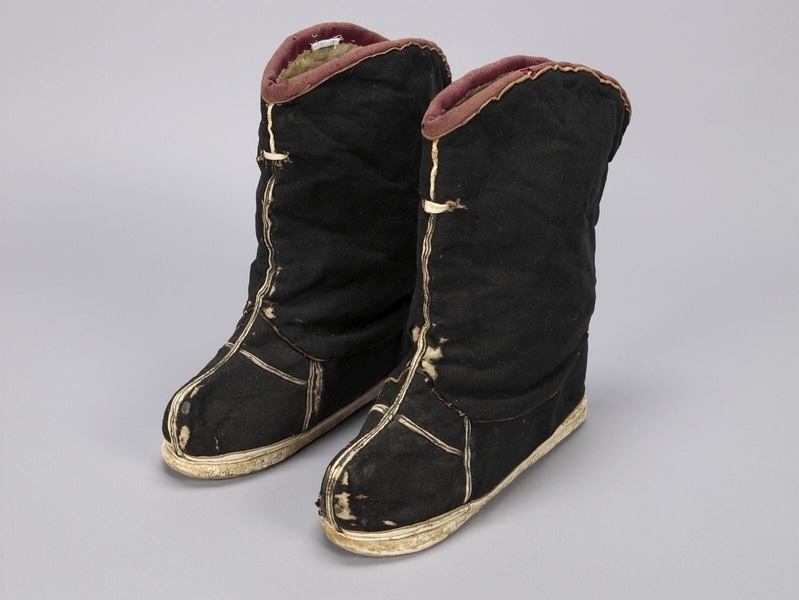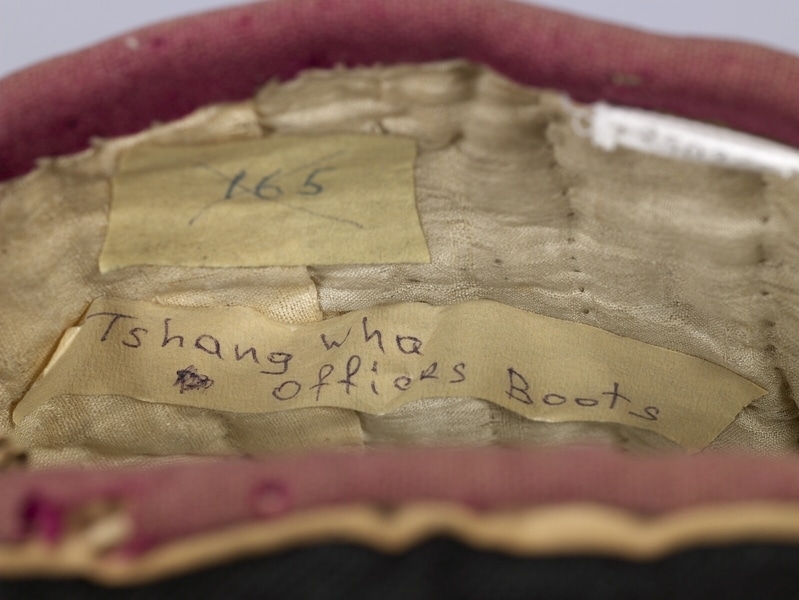Bridegroom's Boots Item Number: 2503/2 a-b from the MOA: University of British Columbia



Description
Pair of black cotton boots with quilted silk lining. Short opening at back. Leather loops on front threaded through two holes and knotted on inside. Piping on front, back and sides. Lower edges of boots trimmed with leather. Soles sewed on. Part (a) has five studs on sole and two pieces of masking tape with writing, attached to lining. Part (b) has four studs on sole.
History Of Use
Such boots were worn by bridegrooms of the official class “yangban”. There were worn with thick quilted socks “boson” underneath, so the man’s foot would be considerably shorter than the boot. The leather strips were used to hang the boots for storage, one threaded through the other. The iron studs in the soles prevented the wearer from slipping. The slit at the back was not only decorative, but also made the boot easier to put on. There is extra cotton cloth in the lining at the front, as it would be rubbed when the wearer walked. In wet weather, oiled paper could be inserted inside the boot. Such boots were made by men who were organized into guilds, such as those who worked with leather. The layers of the boots are: cotton fabric, deerskin, cotton batting, silk. The lower part appears to have been stiffened with canvas made of hemp.
Iconographic Meaning
The silk lining and use of deerskin indicate that the owner was wealthy. Ordinary people would use leather made from the skin of cows. Such boots for bridegrooms were in the style of those worn by officials at court, but those worn by court officials would be more stiff and generally made of more expensive materials. The raised toe represents derivation from a style used by nomadic people, who traveled on horseback.
Item History
- Made in Korea during 1890
- Owned by Helmer Arts Ltd. before January 24, 2000
- Received from Fyfe-Smith Memorial Oriental Collection Fund (Funding source) and Helmer Arts Ltd. (Seller) on January 24, 2000
What
- Name
- Bridegroom's Boots
- Identification Number
- 2503/2 a-b
- Type of Item
- boot
- Material
- cotton fibre, silk fibre, deer skin, skin, hemp fibre, dye, iron metal and paper
- Manufacturing Technique
- tanned, dyed, woven, cut, sewn, forged, shaped and inserted
- Part A
- height 28.0 cm, width 7.5 cm, depth 27.0 cm
- Part B
- height 28.0 cm, width 7.0 cm, depth 26.5 cm
Who
- Culture
- Korean
- Previous Owner
- Helmer Arts Ltd.
- Received from
- Fyfe-Smith Memorial Oriental Collection Fund (Funding source) and Helmer Arts Ltd. (Seller)
Where
- Holding Institution
- MOA: University of British Columbia
- Made in
- Korea
When
- Creation Date
- during 1890
- Ownership Date
- before January 24, 2000
- Acquisition Date
- on January 24, 2000
Other
- Item Classes
- textiles
- Condition
- fair
- Accession Number
- 2503/0002 a-b